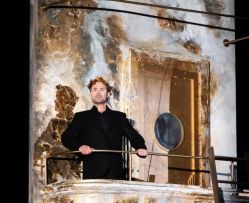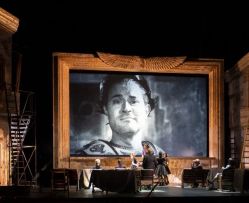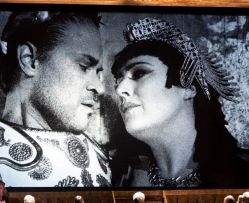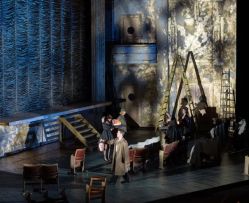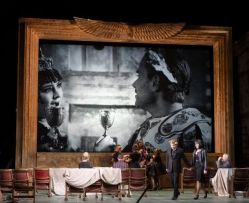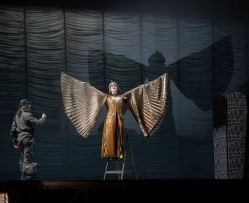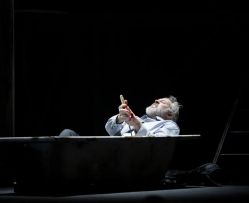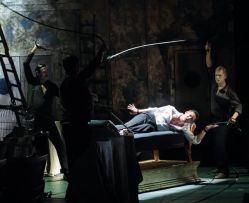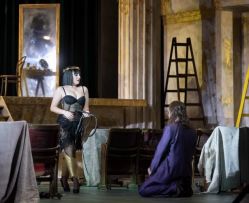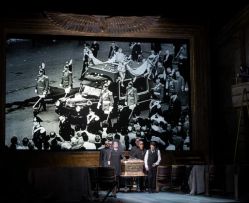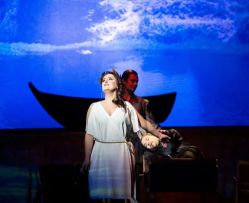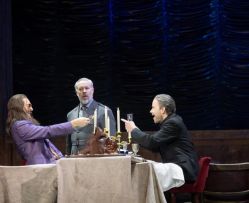Dramma per musica in three acts (1724)
Libretto by Nicola Francesco Haym based on Giacomo Francesco Bussani
Preview:
Tuesday, 14 December 2021, 7 pm, until 10.15 pm (one intermission)
Premiere:
Tuesday, 17 December 2021, 7 pm, until 10.15 pm (one intermission)
Performances:
19 | 22 December 2021 | 7 pm, until 10.15 pm (one intermission)
NEW start time:
29 & 31 December 2021 | 6.30 pm, until 9.45 pm (one intermission)
In Italian with German surtitles
New production of Theater an der Wien
Cast
Synopsis
Giulio Cesare has defeated his political adversary Pompeo and pursued him as far as Egypt. When Cesare arrives there, accompanied by Pompeo’s wife Cornelia and her son Sesto, the people greet him with rapturous cheers. But he is entering a divided land. Tolomeo and his sister Cleopatra are supposed to rule Egypt together, but both claim the right to rule alone. Tolomeo believes that he will be able to win Rome’s powerful ruler as an ally by presenting him with Pompeo’s severed head. The fleeing Pompeo, hoping for sanctuary, immediately fell victim to Tolomeo’s lust for power. But the gift fails to have the desired effect: Cesare is disgusted, and Cornelia and Sesto demand revenge. Meanwhile, Tolomeo’s scheming adviser Achilla has fallen in love with Cornelia and is devising sinister plans to make her his. Cleopatra also tries to use Cesare for her own ends, but she exploits her beauty: disguised as “Lydia” and pretending to be harassed by Tolomeo she appeals to Cesare’s protective instinct. She overhears Cornelia and Sesto planning their revenge and gives them access to Tolomeo. However, their assassination attempt fails and the two of them are arrested. Achilla says that he will release Cornelia and Sesto if Cornelia surrenders to him. She refuses. In the meantime, Tolomeo has also lost his heart to Cornelia and wants to have her too. With a stunning performance, Cleopatra completely entrances Cesare: dressed as the personification of virtue she sings him an enchanting love song. The lovers’ meeting between Cesare and “Lydia” is brutally interrupted when Tolomeo and his troops attack Cesare’s army. Outraged, Cleopatra reveals her true identity and that her love for him is now genuine. The astonished Cesare hurries off to battle. Initially, everything seems to go wrong: Cesare is almost caught by his enemies; only a leap into the harbour basin saves him. Cleopatra is taken prisoner and Cornelia is sexually harassed by Tolomeo. But Sesto stabs Tolomeo to death and in mid-battle Achilla changes sides, furious that Tolomeo was not willing to let him have Cornelia. Cesare swims to safety and goes on shore as a hero. He places Cleopatra on the throne as queen and the lovers are cheered by the populace.
George Frideric Handel created Giulio Cesare in Egitto in London in 1723/24 when he was at the height of his success as a composer of Italian operas. The premiere at the King’s Theatre on Haymarket on 20 February 1724 was a particular triumph. Giulio Cesare remains a mainstay of the opera repertoire today. One reason for this may be that the historical main protagonists continue to fascinate us, but another may well be that the score Handel wrote for it is among his most inspired. Handel’s librettist Nicola Haym adapted and shortened an existing Italian libretto since London audiences did not want to sit through a five-hour opera: three hours was enough for them. During the preparations the cast of singers changed several times, requiring Handel to constantly rewrite individual parts. In the end, the premiere boasted the famous castrato Senesino as Cesare, a singer celebrated all over Europe for his voice and stage presence. Cesare appears here as the ideal hero and lover and every aria presents another facet of his character. In his recitativo accompagnato Alma del gran Pompeo he displays melancholy and magnanimity, since in it he respects and mourns his adversary. The role enabled Senesino to demonstrate the full range of his acting and singing capabilities. The portrayal of Cleopatra by Francesca Cuzzoni, one of the most acclaimed prima donnas of her day, was no less impressive. The Egyptian queen evolves from a self-assured, determined young woman to a ruler who has gained in wisdom through love and mortal danger. Her performance as virtue to charm Cesare is extraordinary. For it, Handel did not compose the dazzlingly virtuoso aria that might have been expected; instead, he wrote a simple melody of indescribable beauty: V’adoro pupille is regarded as one of his best arias. Her Piangerò in Act III, a heart-rending farewell to life, is similarly compelling. Almost half the music in Giulio Cesare is reserved for the two main protagonists: in terms of virtuosity, expressiveness and dramatic power their numbers represent a succession of highlights virtually unmatched in Baroque opera.
About the opera
George Frideric Handel created Giulio Cesare in Egitto in London in 1723/24 when he was at the height of his success as a composer of Italian operas. The premiere at the King’s Theatre on Haymarket on 20 February 1724 was a particular triumph. Giulio Cesare remains a mainstay of the opera repertoire today. One reason for this may be that the historical main protagonists continue to fascinate us, but another may well be that the score Handel wrote for it is among his most inspired. Handel’s librettist Nicola Haym adapted and shortened an existing Italian libretto since London audiences did not want to sit through a five-hour opera: three hours was enough for them. During the preparations the cast of singers changed several times, requiring Handel to constantly rewrite individual parts. In the end, the premiere boasted the famous castrato Senesino as Cesare, a singer celebrated all over Europe for his voice and stage presence. Cesare appears here as the ideal hero and lover and every aria presents another facet of his character. In his recitativo accompagnato Alma del gran Pompeo he displays melancholy and magnanimity, since in it he respects and mourns his adversary. The role enabled Senesino to demonstrate the full range of his acting and singing capabilities. The portrayal of Cleopatra by Francesca Cuzzoni, one of the most acclaimed prima donnas of her day, was no less impressive. The Egyptian queen evolves from a self-assured, determined young woman to a ruler who has gained in wisdom through love and mortal danger. Her performance as virtue to charm Cesare is extraordinary. For it, Handel did not compose the dazzlingly virtuoso aria that might have been expected; instead, he wrote a simple melody of indescribable beauty: V’adoro pupille is regarded as one of his best arias. Her Piangerò in Act III, a heart-rending farewell to life, is similarly compelling. Almost half the music in Giulio Cesare is reserved for the two main protagonists: in terms of virtuosity, expressiveness and dramatic power their numbers represent a succession of highlights virtually unmatched in Baroque opera.
